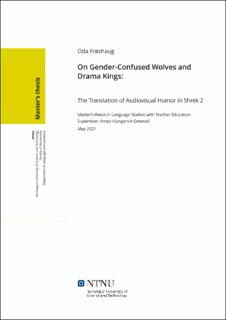| dc.description.abstract | This study deals with the issue of interlingual translation of humor, and how humor translates in dubbing contra subtitling in audiovisual text. The movie Shrek 2 is used as a source of data collection, where a selection of eight consecutive jokes and their dubbed and subtitled Norwegian translations are analyzed and compared with particular focus on translation strategies and priorities. In the analysis process, two humor categorization models are used for the purpose of classifying humor types before and after the translation, for discovering which elements that have been altered or changed in the translation, and for the purpose of detecting similarities and differences between the dubbed and the subtitled target texts. These models are Martínez-Sierra’s taxonomy of humorous elements, which is a classification tool particularly customized for the purpose of categorizing both verbal and non-verbal humor in audiovisual texts, and Attardo’s general theory of verbal humor, which divides elements of verbally expressed humor into levels in terms of importance, and is concentrated on how humor is constructed and also reconstructed in a translation process (2006, 1991). The study found that dubbed and subtitled audiovisual translations of humor seem to be translated similarly to one another and correspond closely to the source text on most occasions, looking away from the changes that are made with regard to the genre restrictions of dubbing and subtitling, such as lip synchronization and time- and space limitations. In jokes where similar translations have not been made, the source text often appear to contain some sort of cultural reference which is problematic to transfer literally at the same time as humor is conserved. Such translations may be particularly difficult to translate due to the lack of similar or corresponding expressions or references in the target language, which again makes a literal translation more difficult to grasp for an audience with a different cultural background than the one presented in the source text. On this matter, dubbed and subtitled target texts are translated differently, as the dubbed target text offers more big changes to conserve humor than the subtitled target text. Reasons for this seem to have to do with the restrictions of the target text genre, as well as priorities and the skopos of dubbed and subtitled target texts. The translation differences that can be detected here indicate a distinction in translation priorities in order for the dubbed and subtitled texts to serve their purpose intended for target audiences. Where the dubbed target text aims to replace the source text and at the same time maintain an equally humorous feeling, the subtitled target text aspires to make the source text available to the target audience by offering a more literal translation of the text. | |
